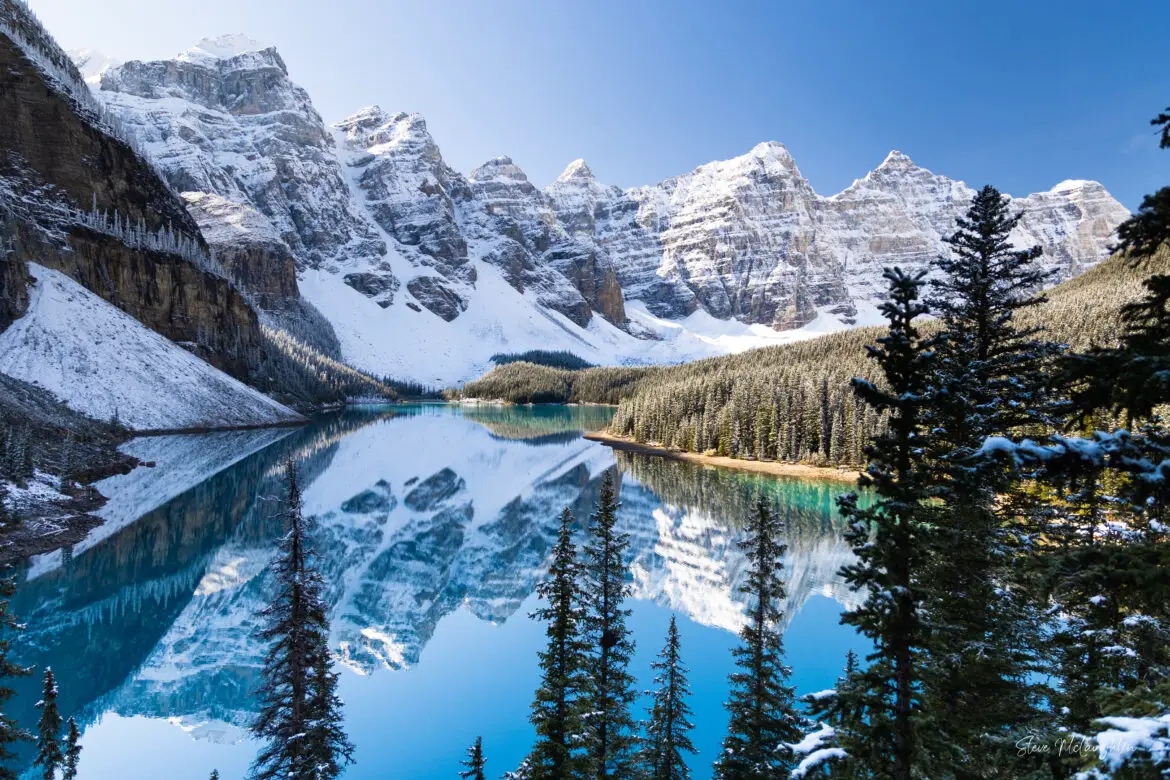If you just started planning your trip to Banff, you’re in for such a treat! Banff National Park is easily one of the most beautiful places in Canada – and maybe even the world. There are so many sights to see, places to stay and things to do – any time that you can spend here is so worth it.
From the iconic Lake Louise to the charming town of Banff itself, we’ll explore the must-see attractions, hidden gems, and practical tips that will ensure your journey through this alpine paradise is nothing short of unforgettable.
Pack your hiking boots, grab your camera, and prepare to be awestruck by the majesty of Banff National Park.
Table of Contents
Get to Know the Region
Banff National Park is a large expanse of land located in the province of Alberta, Canada. It is quite a unique area that is both wild and well traveled, with over 4 million visitors passing through the region each year!
Established in 1885, Banff is Canada’s oldest national park and covers an impressive 6,641 square kilometers (2,564 square miles) of stunning Rocky Mountain landscape. The park is world renowned for its breathtaking scenery, featuring snow-capped peaks, turquoise glacial lakes, forests, and abundant wildlife.
The park offers year-round recreational opportunities. In the summer, visitors can enjoy hiking, mountain biking, canoeing, and rock climbing. Winter snow fall brings world-class skiing, snowboarding, and ice skating.
The Town of Banff, which is located just inside the park boundaries, is a charming little mountain town. Serving as a hub for tourists and adventurers, you’ll find most of the accommodations, dining, shopping, and cultural experiences here.
Banff National Park plays a crucial role in preserving Canada’s natural heritage and serves as a model for balancing conservation with tourism and recreation. Its unique blend of natural beauty, outdoor adventure, and rich history makes it a must-visit destination for nature enthusiasts and travelers from around the globe.
The Town of Banff
As you can see, the Town of Banff is not very big, and easy enough to get around on foot. Most of the hotels, restaurants and shopping are centered around Banff Avenue.
There’s lots to see and do just within the town itself, like the Hot Springs, Vermillion Lakes, Cave and Basin, Fairmont Hotel, and Bow Falls. Some relatively easy hikes in this area include Tunnel Mountain, Fenland Trail and the Hoodoos.
If you’re in good shape and up for the adventure, it’s also possible to hike the other three mountains you can see from the town site: Rundle, Cascade, and Sulphur (where the Banff Gondola is located.)
Neighbouring Parks
Banff National Park is part of a larger protected area in the Canadian Rockies, surrounded by several other stunning national parks:
- Jasper National Park
Located north of Banff, Jasper is the largest national park in the Canadian Rockies. It’s connected to Banff by the scenic Icefields Parkway. Jasper is known for its diverse wildlife, the Columbia Icefield, Maligne Lake, and the Jasper Skytram. The Town of Jasper has its own distinct atmosphere from Banff. [Note: this park is currently CLOSED due to wildfire in July 2024.] - Yoho National Park
Situated west of Banff in British Columbia, Yoho is home to Takakkaw Falls, as well as the stunning Emerald Lake. There’s also an adorable little town called Field along the way that’s a great place to have lunch and watch the trains. You can fit these three sights into a day trip from Banff. (As soon as you start driving closer to the mountains, you’ll be amazed with how massive they are.) Yoho is also famous for the Burgess Shale fossil beds, a UNESCO World Heritage Site. - Kananaskis Country
This collection of provincial parks are much quieter than Banff, and offer great hiking trails, camping, and opportunities to see wildlife – especially grizzly bears! - Kootenay National Park
Located southwest of Banff, also in British Columbia, Kootenay features the colorful Marble Canyon, the Paint Pots (mineral springs), and Radium Hot Springs. - Mount Revelstoke National Park
While not directly bordering Banff, this park is relatively close, located further west in British Columbia. It’s known for its unique inland rainforest and the Meadows in the Sky Parkway, a scenic drive through subalpine wildflower meadows. - Glacier National Park (Canada)
Not to be confused with its American namesake, this park is west of Banff in British Columbia. It’s known for its deep valleys, dense forests, and over 130 glaciers. The park is perfect for hiking and mountaineering.
Some of these parks, along with Banff, form a large protected area known as the Canadian Rocky Mountain Parks World Heritage Site. If you have a week or two to spare, many visitors to Banff extend their road trip to venture into the neighboring parks.
Best Time of Year to Visit Banff
Each season holds its own charm, with different activities you can do. While summer is the busiest season, winter holds its own charm (especially if you love skiing!) and fall is becoming a more popular time to visit as well.
Summer (June – August)
Summer is by far the busiest and most popular season. The weather is beautiful and temperate, and you can see the lakes in their full turquoise brilliance. It rarely gets super hot in Banff, as you can always feel the alpine breeze cooling you down!
The warm weather and long daylight hours give you full access to hiking trails, the famous Icefields Parkway, campgrounds, and the back country. Summer visitors can enjoy the sightseeing, wildflowers, and wildlife. (Yes, you’ll have to watch out for bears!)
But it’s not all sunshine: with peak tourist season comes the bigger crowds, higher prices, mosquitoes, and limited vacancies. You’ll definitely need to book your lodgings and activities ahead of time to really enjoy your stay in the summer.
Summer is also wildfire season in Western Canada, and with it comes the smoke. If you visit while fires are active, it can really affect your views of the mountains and sometimes even your travel routes. It’s tough to really plan for this, as the fires can pop up quite unpredictably through British Columbia and Alberta.
Fall (September – October)
Once considered the shoulder season, fall is becoming a popular time to visit Banff. September has always been our favourite month to visit the park!
Fall in Banff National Park brings the crisp anticipation of winter while the cozy summer warmth continues. Mid- to late- September is larch season, when these trees turn a striking bright yellow in the sunlight.
The crowds thin out towards mid-September, giving you a quieter experience and easier access to the popular attractions. The road to Moraine Lake is still open until mid-October, alongside the other famous spots.
The cooler temperatures are perfect for hiking and outdoor activities, with the added bonus of fewer bugs.
Wildlife are much more active in the day time, and you can spot animals like grizzly bears and pikas busily preparing for the winter. Elk rutting season takes place during this time, and you can watch the males trying to impress the ladies.
Fall visitors should be prepared for unpredictable weather, with the possibility of early snowfall, especially at the higher elevations. Some summer facilities and trails may begin to close towards the end of the season as the daylight hours grow shorter.
Whether you’re seeking solitude on a hiking trail, hoping to spot elk during their rutting season, or simply wanting to soak in the autumn beauty, fall in Banff offers a memorable and often more budget-friendly experience than the peak summer months.
Winter (November – February)
Winter transforms Banff National Park into a magical snow-covered wonderland, offering a distinctly different experience from other seasons. The landscape becomes a pristine canvas of white, with frozen lakes, snow-laden forests, and glistening ice creating breathtaking scenery.
Winter sports enthusiasts flock to the park for world-class skiing and snowboarding at the Big Three resorts: Lake Louise, Sunshine Village, and Mt. Norquay.
Other popular activities include ice skating on frozen lakes, snowshoeing through silent forests, and soaking in the steaming hot springs after a long day exploring the winter wonderland.
The town of Banff takes on a cozy, festive atmosphere with twinkling lights and seasonal events. If you visit at the end of December, you can experience Christmas in Banff!
Most wildlife species are still active during the winter, with a chance to spot elk, deer, bighorn sheep, coyotes, and possibly even wolves against the snowy backdrop. This is the perfect time of year to photograph animals with their thick, plush coats and less greenery obstructing your views.
Winter visitors must prepare for cold temperatures, limited daylight hours, and potential road closures due to the snow. While most of the famous lakes (including Lake Louise) are still accessible, they’re covered in ice. Some hiking trails and facilities are inaccessible, and warm winter gear is a must.
Many find the serene beauty, smaller crowds, and unique winter activities make Banff an unforgettable winter destination.
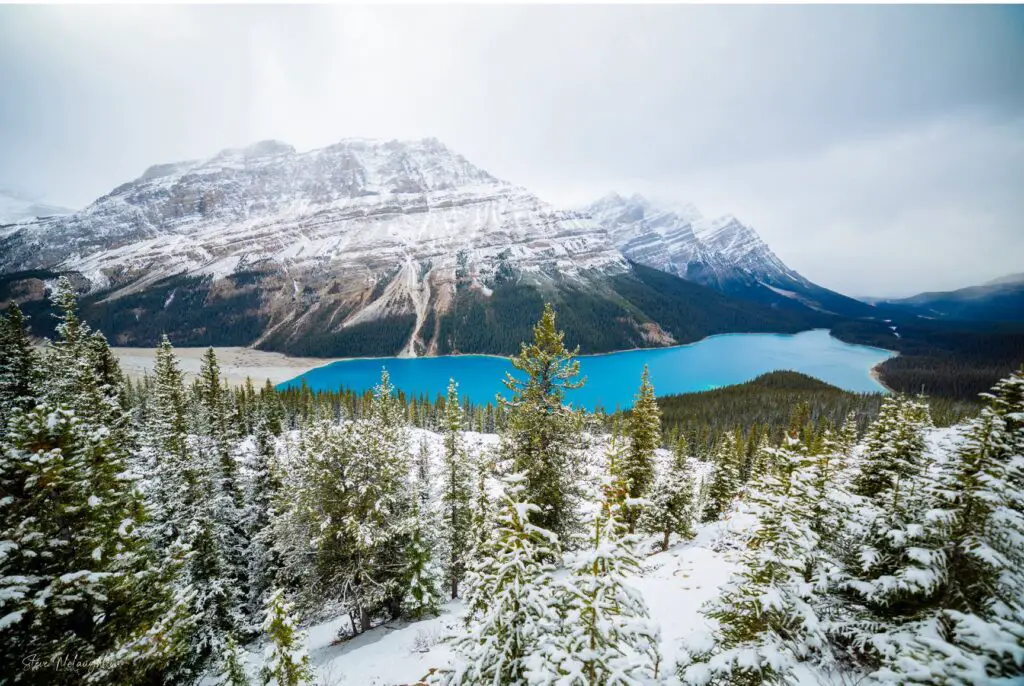
Spring (March – May)
This shoulder season provides a quieter, more intimate experience with fewer crowds and lower prices compared to the peak summer months. It’s still cold during these months, and road closures can still be in effect. The famous turquoise lakes are typically still frozen or just starting to melt, and you wont be able to see Moraine Lake until the road opens in June.
As the snow begins to melt in the late spring, the landscape starts to come alive with waterfalls, budding trees, and early wildflowers peeking through the receding snow.
Grizzly bears are already climbing out of their winter dens, hungry and searching for dandelions along the side of the roads. Many species of wildlife, including elk and bighorn sheep, look very patchy during this season as they shed their winter coats.
Spring skiing is possible at higher elevations, while the lower areas start opening up for hiking and biking. Trails are often muddy, slippery and wet during this season, with lingering ice in the shade. So come prepared with good traction on your hiking boots!
Spring visitors should be prepared for unpredictable weather, ranging from sunny, warm days to unexpected snowstorms. Banff can be quite rainy as well towards the end of May and early June.
Regardless of the time of year that you visit, expect cooler temperatures at higher altitude locations like Lake Louise and Moraine Lake. Visit our packing list to make sure you take everything you need!
Things To Do in Banff
There’s never any shortage of things to do in Banff! Wildlife spotting has always been one of our favourite things (we may be a little biased…) as well as hiking and seeing all the major sights (listed below).
If you’re adventurous, you might want to try horse back riding, canoeing, mountain climbing, and of course skiing in the winter time!
Getting to Banff
Being such a popular tourist destination, Banff is very well connected and you have lots of different options for getting here. You can drive yourself, book a shuttle, take public transportation or book through a tour company. You can also take a taxi or Uber from Calgary, but this option is quite expensive.
The nearest airport to Banff is located in Calgary (YYC). It takes about 1.5 – 2 hours to get from Calgary to Banff, depending on the traffic. The road from Calgary to Banff isn’t too bad for traffic most of the time, but can be very congested around the holidays. May 24 weekend and July 1 (Canada Day) are popular dates for Calgarians to visit Banff.
Another route is to fly into Edmonton (YEG), drive to Jasper, and then drive the breathtaking Icefields Parkway that connects Jasper to Banff. Edmonton to Jasper is a 4 hour drive. The route between them is not the most exciting one until you start to reach Jasper – but your chances of spotting some wildlife are pretty good!
Driving your own vehicle (or a rental car) is a great option if you like the freedom to go wherever you like and follow your own schedule. With that said, parking for the major sightseeing locations can be extremely crowded. Particularly at mid-day during the summer time. Some of the most popular sights, like Lake Louise, even start filling up early in the morning. Typically, your accommodations will provide parking – but the Town of Banff can be challenging sometimes to find parking in.
If you don’t feel like driving, it’s super easy to get to and around Banff without a vehicle. The Banff Airporter is our favourite option to get to Banff, as it’s quite affordable and runs on a flexible schedule directly from the airport.
Public Transportation in Banff
The Banff region has its own public transportation, making it super convenient to tour around without a car.
The Roam bus runs in between Banff and its neighboring town of Canmore (about 20 minutes away). As well as between Banff and Lake Louise. It can also take you to popular spots like the Banff Gondola, Cave and Basin, Johnston Canyon and Minnewanka Lake.
The Roam bus does NOT cover the Icefields Parkway between Banff and Jasper.
Some, but not all, of the Roam bus routes have accessibility features for wheelchairs, as well as priority seating for people with limited mobility. Check the routes on their website to confirm.
They do allow service dogs, as well as small pets inside of a carrier that fits on your lap.
Regardless of how you get to Banff, you will need a Park Pass. You can buy one at the gate when you enter the park, or purchase one online to skip the line-ups.
The Banff Bucket List
Most of Banff’s attractions involve absolutely stunning natural lakes, mountains and hiking trails. Many locations are easily accessible by vehicle or tour bus, and don’t require significant hiking to get to. So the amount of physical activity you plan for your trip is completely up to you!
Depending on how many days you have, you might choose to see some, or all of these locations. If you’re really limited on time, a great way to make sure you see the important ones is to book through one of the region’s many tour companies.
Lake Louise and Moraine Lake
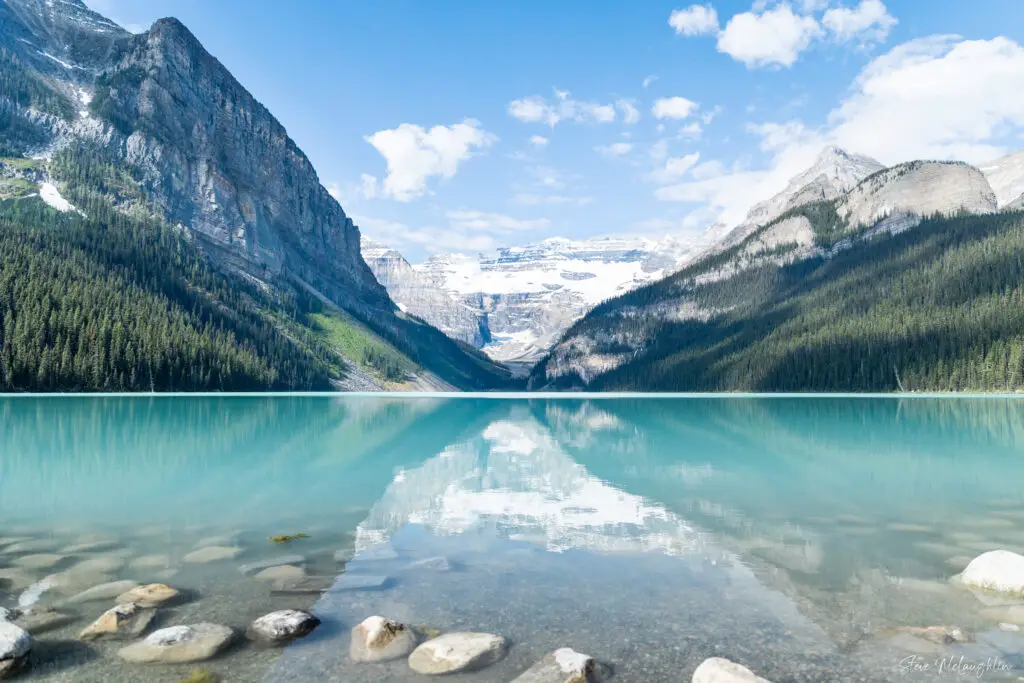
These two neighboring lakes are a definite must-see on any trip to Banff. Depending on how much time you have, you can spend around an hour at each lake just taking in the beauty (and of course a few photos.) Or, you can plan to spend more time here hiking, boating, and enjoying yourself.
Getting to these lakes has become a little bit trickier in recent years. Parking gets extremely crowded at Lake Louise, and you can no longer drive to Moraine Lake in your own vehicle. Instead, shuttle and tour buses now exclusively take visitors up this windy mountain road.
Moraine Lake is only open from June 1 – October 14th each year (weather permitting) as the road in becomes an avalanche hazard in the winter time. But Lake Louise is open all year round. You can even ice skate on it in the winter time after it freezes over.
You can read more about Moraine Lake here and get the Low Down on the Moraine Lake Shuttles.
Johnston Canyon
This beautiful limestone gorge, carved by thousands of years of water erosion, is an easy and well-marked hike through a narrow canyon to view the waterfalls, pools, and unique rock formations.
The canyon trail, which is partly built into the canyon walls, leads hikers through a lush forest and along elevated catwalks that cling to the rocky cliffs. As you make your way along the path, you’ll be treated to breathtaking views of the rushing creek below and the towering canyon walls above.
The hike features two main attractions: the Lower Falls and the Upper Falls. The Lower Falls, reached after a relatively easy 1.1 km walk, thunders through a narrow chute and can be viewed from a small cave in the canyon wall. The Upper Falls, a more challenging 2.7 km from the trailhead, offers a spectacular view of a 30-meter waterfall cascading down the rock face.
Definitely aim to arrive early in the morning or later in the evening to avoid the crowds. This can be a bumping spot and tough to find parking in the summer time.
Lake Minnewanka
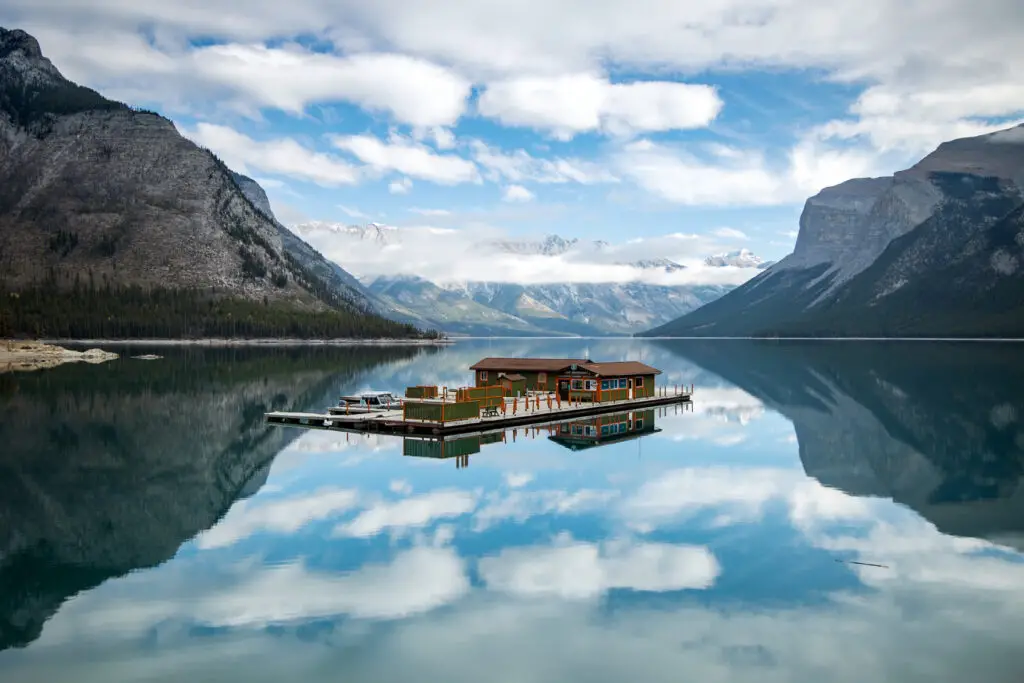
Lake Minnewanka is a glacial lake that stretches 21 kilometers through a picturesque valley close to the town of Banff.
Its shores are home to lots of wildlife, including bighorn sheep and deer, making it a prime spot for nature enthusiasts and photographers.
Lake Minnewanka is a popular destination for different activities. In summer, visitors can enjoy a scenic cruise, learning about the area’s history and geology while taking in the panoramic views. The fishing is great, with the chance to catch lake trout and Rocky Mountain whitefish. The lake’s shoreline offers excellent hiking and mountain biking trails, including the popular Minnewanka Loop.
Lake Minnewanka is one of the few lakes in Canadian National Parks to allow boats with motors. You can even scuba dive here, with a unique experience exploring a submerged town that was flooded when the lake was dammed in 1941.
In winter, the frozen lake becomes a playground for ice skating, cross-country skiing, and fat biking. The area is also known for its dark sky preserve status, making it the perfect location for stargazing and viewing the northern lights.
Insider tip: Sign up for alerts from Aurora Watch to get e-mails on nights when geomagnetic activity is high. This gives you the best chances of spotting the Northern Lights!
Peyto Lake
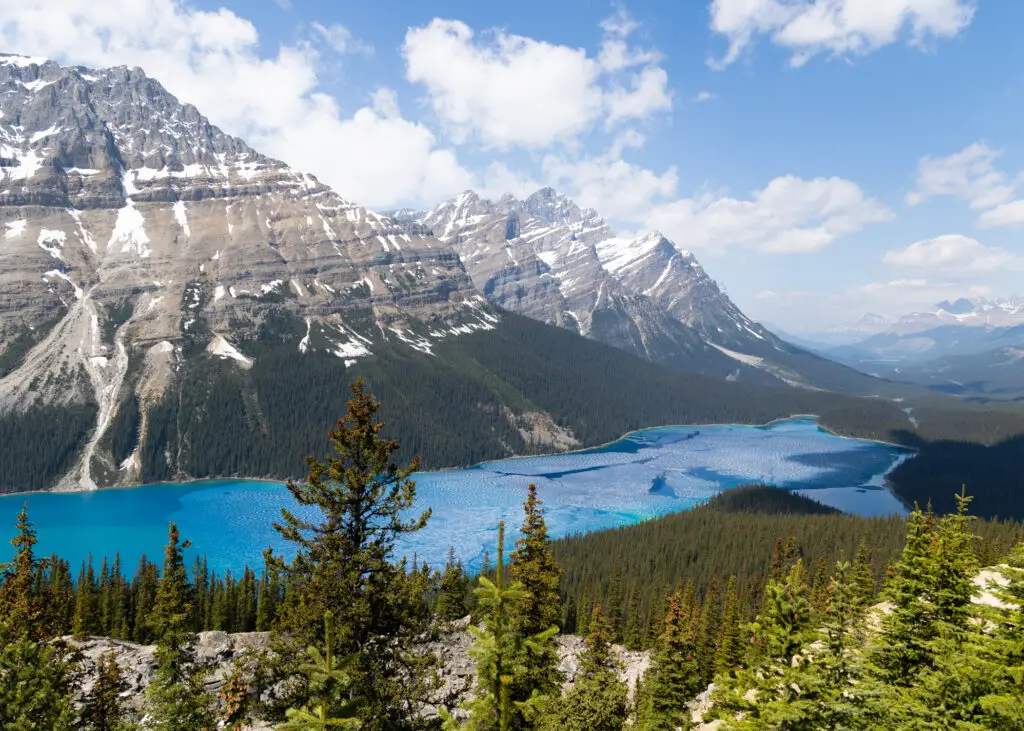
This wolf-shaped lake is well worth a visit if you have your own transportation. The huge lake nestled within the valley really gives you a feel for the expansive scale of the landscape and sky. There’s only a short walk from the parking lot to the viewing platform, and lots of longer hiking trails around this area too.
Learn more about Peyto Lake by clicking here.
Vermillion Lakes
The Vermilion Lakes are a series of three shallow lakes. Located just a few minutes’ drive from the town of Banff, these picturesque lakes offer visitors breathtaking views of the mountains reflected in their calm waters.
The lakes are especially beautiful during sunrise and sunset when the surrounding mountains are bathed in golden light. This is a great vantage point to photograph Mount Rundle, Sulphur, and Tunnel.
The scenic drive winding along the shores of the lakes gives you lots of pullouts to stop and admire the view, have a picnic, or launch a canoe or kayak. You can also explore on foot using the easy trail follows the lakeshore, ideal for walking, jogging, or cycling.
The Vermilion Lakes are also a haven for wildlife. Birdwatchers will love the variety of waterfowl and shorebirds that frequent the area, including loons, ospreys, and bald eagles. Lucky visitors might spot larger animals like elk, deer, or even the occasional bear.
Banff Upper Hot Springs
The Banff Upper Hot Springs lets you soak in naturally heated mineral waters while enjoying breathtaking views of the mountains. Located near Sulphur Mountain, these hot springs have been drawing visitors to Banff for over a century!
The water in the springs is heated geothermally, bubbling up from 3 km beneath the Earth’s surface at a temperature of about 116°F (47°C) before being slightly cooled. Rich in minerals like sulfate, calcium, bicarbonate, magnesium, and sodium, the waters are believed to have therapeutic benefits. You’ll definitely notice how soft your skin is afterwards!
The pool is outdoors, so you can enjoy the crisp mountain air and stunning alpine scenery while you take a dip in the hot soothing waters. In the winter, the experience is especially magical, with the steam rising against a backdrop of snowy peaks.
Facilities at the Upper Hot Springs include a large pool, a café, a gift shop, and rental services for old-school style swimsuits and towels. The site also features interpretive displays that share the fascinating history and geology of the hot springs.
Morant’s Curve
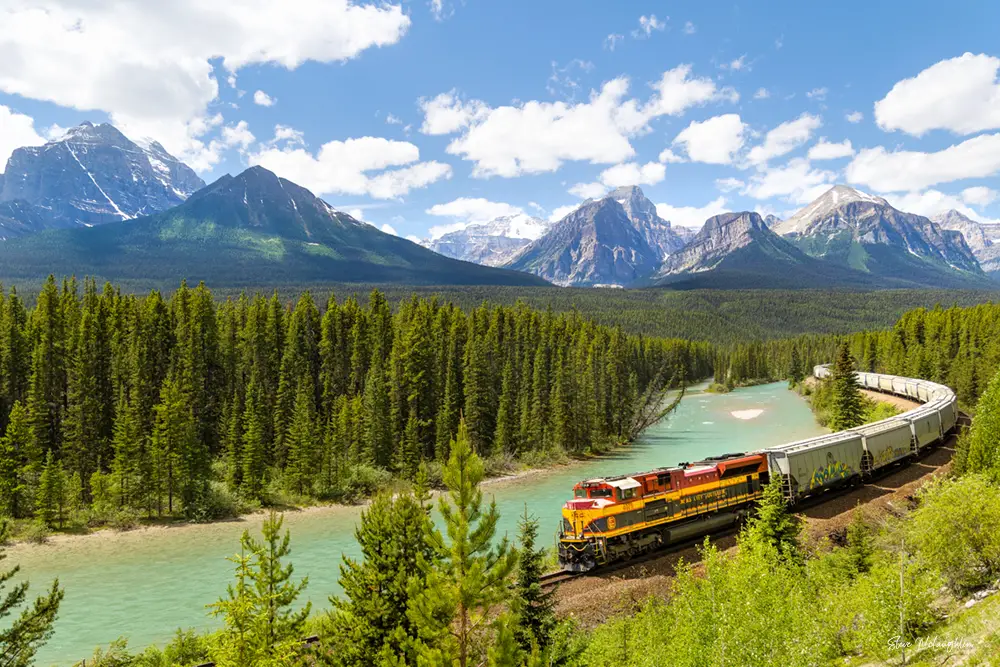
This viewpoint is a great place to spot the historic Canadian Pacific Railway trains as they wind through the mountains. The perfect interplay between the trains, the teal blue Bow River, and surrounding mountain peaks make this one of the most popular spots in the Rockies for train photography. Situated along the Bow Valley Parkway in between Banff and Lake Louise, you’re likely to spot lots of wildlife around this area as well.
Learn more about visiting Morant’s Curve here.
Bow Falls
Bow Falls is a wide, low waterfall and one of Banff National Park’s most accessible natural attractions. Located just a short distance from downtown Banff, these falls give visitors a spectacular view of the power and beauty of the Bow River as it cascades over a limestone ledge.
The falls are easily accessible via a short, paved walking trail that offers several viewpoints. From these vantage points, you can not only admire the falls themselves but also take in breathtaking views of the surrounding mountains, including Mount Rundle and Sulphur Mountain.
In addition to being a prime spot for photography, the area around Bow Falls is popular for picnicking, short hikes, and wildlife viewing.
During winter, the partially frozen falls create a stunning ice sculpture. The Bow Falls viewpoint is also a great starting point for longer walks or bike rides along the Bow River.
Fairmont Hot Springs Hotel
Even if you aren’t staying at the Fairmont, this historic, castle-like hotel is well worth checking out! It’s only a short walk from downtown Banff, and a popular spot for elk to hang out.
The Fairmont almost forms its own little village. Visitors are allowed on the first floor, where you can find many upscale shops, art galleries and cute little cafes. The grounds are also accessible with gorgeous flower gardens in the summer time. The view from the back of the Fairmont is absolutely stunning as well, with the Bow River running through a valley between the mountains.
Another great vantage point to view and photograph this hotel is from Surprise Corner in Banff, with the beautiful Bow River running in between.
Wildlife Spotting in Banff
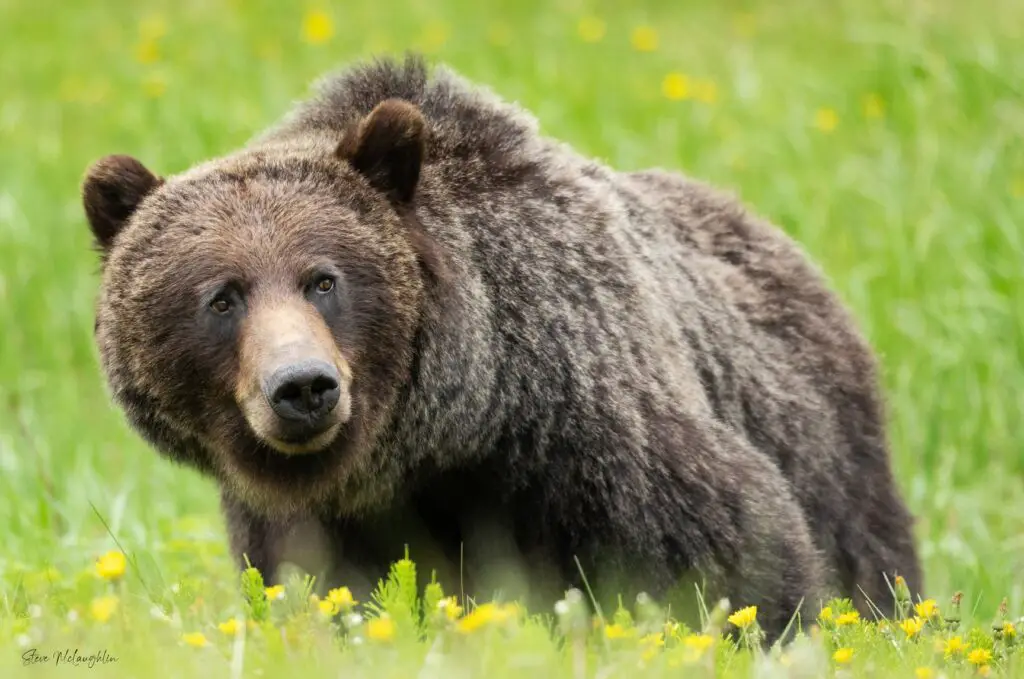
Banff is a wild place and chances are, you will see some animals! Including grizzly bears, black bears, elk, bighorn sheep, mountain goats, and wolves.
Just keep in mind that they are indeed wild! It’s illegal to feed animals in the Park – including the birds – and best for everybody if you keep a safe and respectable distance from them.
Photograph only using a telephoto lens, and don’t block the roadways while watching animals.
You may be able to spot The Boss Bear on your trip, as he’s known to hang around near the Town of Banff.
Where to Stay in Banff
Accommodations can definitely be the priciest part of a stay in Banff, especially if you visit during the busiest months of July and August. Plan to book at least 6 months before your trip, as they do fill up ahead of time. It can be a major challenge to find last minute affordable accommodations!
You can also consider booking accommodations in the nearby towns of Canmore or Lake Louise, which are only a short drive (or public bus ride) away from the Town of Banff.
Just zoom out on the map below to see available options in Banff and its neighbouring towns.
Another option is to stay in the nearby city of Calgary. This could be a more cost effective option if you plan on taking a tour through Banff rather than driving around the park yourself. Many of the tours to the major sightseeing locations leave from here. Just keep in mind: Calgary can also be busy during the first two weeks of July when the Calgary Stampede takes place.
In terms of accommodations, you can find just about everything in and around Banff from luxury and mid-range hotels, to bed and breakfasts, to a more rustic camping experience. (Just like with hotels, the campsites are often booked out a year ahead of time!)
Enjoy Your Trip!
This slice of the Canadian wilderness offers an experience that lingers long after you’ve left its towering peaks and pristine lakes behind. From the thrill of spotting wildlife in their natural habitat to the serenity of stargazing in some of the darkest skies in North America, Banff creates memories that last a lifetime.
Whether you’ve come for adventure, relaxation, or a bit of both, Banff National Park delivers in spades. We hope this article helps you turn your trip plan into reality. See you in Banff!
